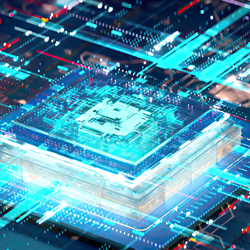Energy-Efficient Memory Materials
 In the current era of Big Data, with over 150 zettabytes of data being created and replicated globally, the energy consumption of information and communication technologies (ICT) is rising exponentially. A significant portion of this energy is wasted as heat due to the Joule effect (i.e., from electric currents required to operate memory devices). Additionally, traditional computers have separate memory and data processing units that must continuously communicate, leading to substantial time and energy expenditure.
In the current era of Big Data, with over 150 zettabytes of data being created and replicated globally, the energy consumption of information and communication technologies (ICT) is rising exponentially. A significant portion of this energy is wasted as heat due to the Joule effect (i.e., from electric currents required to operate memory devices). Additionally, traditional computers have separate memory and data processing units that must continuously communicate, leading to substantial time and energy expenditure.
Given the limitations of current computing devices, advancing ICT has become increasingly challenging. A paradigm shift in computing is essential. Presently, several strategies aim to develop memory devices that emulate the human brain, where data storage and processing occur in the same unit (in-memory neuromorphic computing). Various materials are being explored for this purpose, including memristive, spintronic, ferroelectric, multiferroic, magneto-ionic, 2D or phase-change materials. In addition to new materials, advanced computing concepts are also being developed, such as deep, spiking, recurrent, or Hopfield neural networks. Other approaches include reservoir, photonic, thermodynamic,or analog computing, amongst others.
This Special Topic brings together scholars from diverse scientific disciplines—physics, chemistry, materials science, engineering—to explore all aspects related to advanced materials for energy-efficient memories, from fundamentals to applications.
This special topic is co-organized by APL Materials. Authors are welcome to submit to either journal for this Special Topic.
Topics covered include, but are not limited to:
- Ferroelectric materials
- Topological insulators
- Reservoir computing
- Skyrmion and domain wall memories
- Wide band gap semiconductors
- In-memory computing
- Magnonic materials (spin waves)
- Opto-electronic memristors
- Magnetic tunnel junction (MTJ)
- Multiferroic materials
- Token-based computing
- Spin transfer torque (STT) memory
- Spintronic materials
- Neuromorphic or brain-inspired computing
- Spin orbit torque (SOT) memory
- Redox-based memory
- Deep neural networks
- Memristive memories
- Metal oxide resistive switching memory
- In-memory logic
- Voltage-controlled magnetic memories
- Conductive bridge random-access memory (RAM)
- Spiking neural network (SNN)
- Phase change memories
- Perovskite memristors
- Convolutional neural network (CNN)
- Stochastic and probabilistic computing
- Electrochemical random-access memory (ECRAM)
- Recurrent neural network
- Thermodynamic computing
- Organic memristors
- Hopfield networks
- Photonic computing
- Molecular memristors
- In-materia computing
- Combinatorial optimization
- 2D semiconductors
- Ising machine
- Analog computing
Guest Editors
Karin Everschor-Sitte, Universität Duisburg-Essen
Daniele Ielmini, Politecnico di Milano
Jordi Sort, Universitat Autònoma de Barcelona, Associate Editor, APL Materials
Monica Lira-Cantu, Catalan Institute of Nanoscience and Nanotechnology, Editor-in-Chief, APL Energy
